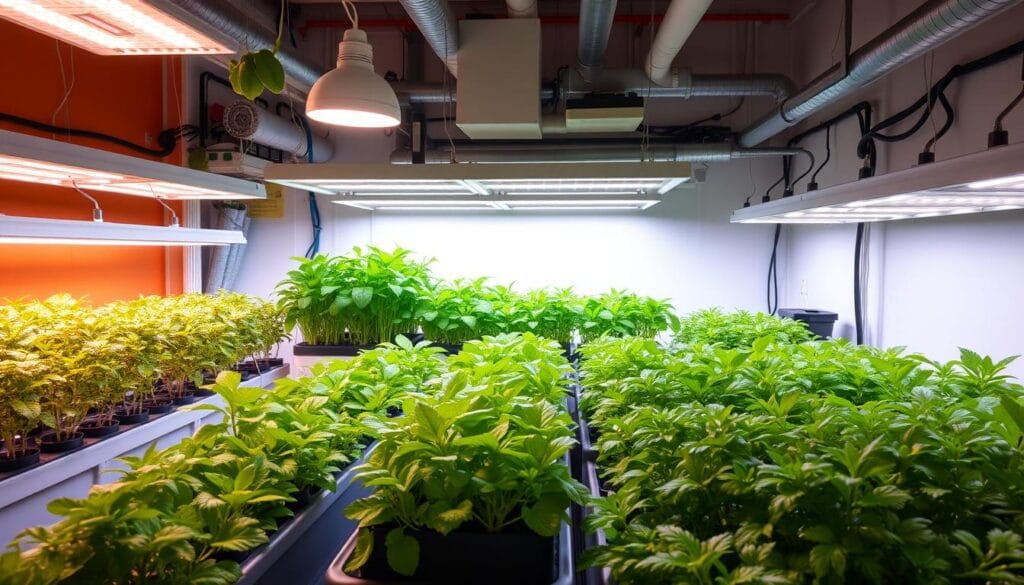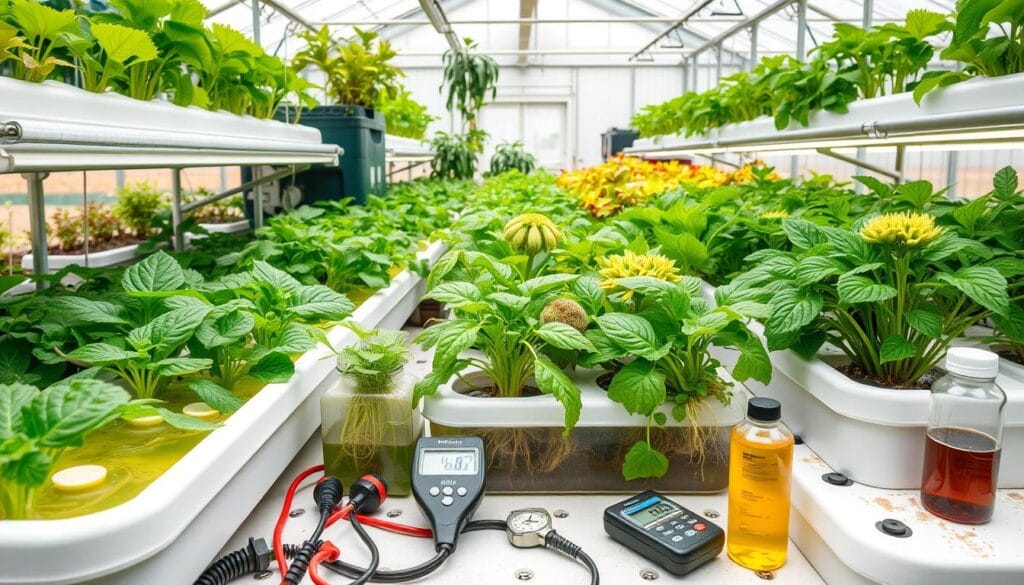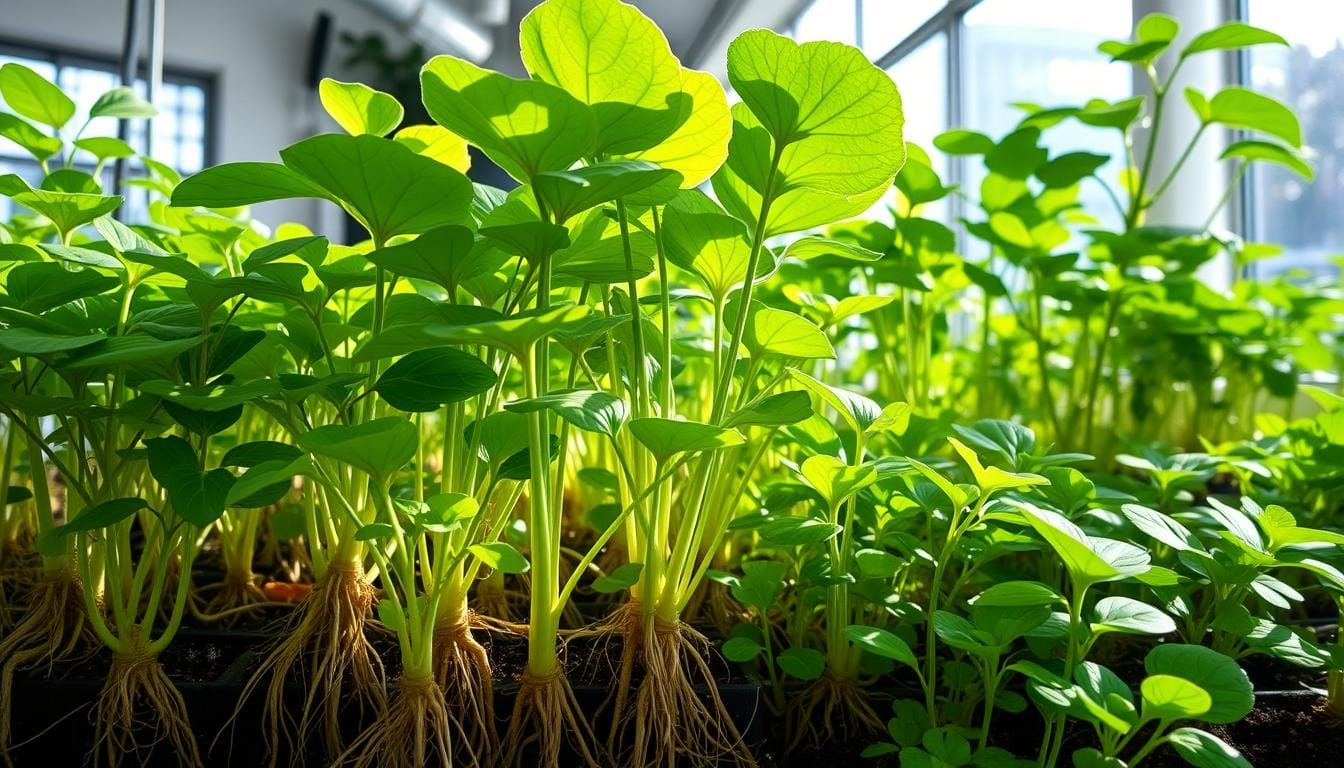Boost Plant Growth: I’ve always wanted my plants to grow strong and healthy. I found that soilless media is a game-changer. It’s perfect for anyone, whether you have a small space or a big garden. Here are nine easy tips to help your plants grow better with soilless media.
Key Takeaways
- Soilless media cultivation offers sustainable and efficient crop production methods
- Hydroponics, a method of growing plants without soil, relies on nutrient-rich water systems
- Soilless media provides better control over nutrient availability and pH levels
- Soilless media reduces dependency on pesticides and herbicides
- Soilless media improves water efficiency for gardening and urban farming
Understanding Soilless Media Cultivation: A Modern Approach to Gardening
Soilless media cultivation is a new way to garden. It brings many benefits that change how we grow plants. This method, also known as hydroponics or controlled environment agriculture, doesn’t need soil. It’s a green and smart choice.
Benefits of Soilless Growing Systems
- Faster plant growth: Soilless gardening can lead to up to 30% faster plant growth compared to traditional gardening methods.
- Improved nutrient absorption: Soilless systems can help plants absorb nutrients more efficiently, resulting in larger and more abundant harvests.
- Water conservation: Hydroponic and soilless systems are highly efficient in water usage, saving up to 90% more water than traditional farming methods.
- Reduced pest and disease risks: Soilless gardening eliminates soil-borne diseases, reducing the need for pesticides and herbicides while increasing plant health.
Key Components of Soilless Media
Soilless potting mixes use organic and inorganic materials. These include coconut coir, perlite, vermiculite, and controlled-release fertilizers. They help plants grow well by holding water, providing air, and giving structure.
Environmental Impact and Sustainability
Soilless gardening is better for the environment than old farming ways. It’s great for cities and places with little land. Hydroponic systems fit well in vertical greenhouses and small spaces, perfect for city farming.
“Soilless potting mixes mark a significant advancement in sustainable agriculture, enhancing nutrient control and reducing disease risks.”
Essential Components of Quality Soilless Growing Media
To grow a thriving soilless garden, you need to know the key parts of a good growing medium. These mixtures are made of organic and inorganic materials. Each part helps plants grow well.
Coconut coir is a green choice instead of peat moss. It holds water well and lets air in. Perlite and vermiculite add structure and help with water. Controlled-release fertilizers give plants the nutrients they need.
A common mix is 1 part coco coir or peat moss, 1 part perlite or vermiculite, and 2 parts compost. You can also add worm castings, mycorrhizae, and slow-release fertilizers. But, they’re not needed for all setups.
“The key to a thriving soilless garden lies in the perfect blend of media components that nourish and support your plants.”
The quality of your growing media is very important. It affects how healthy and productive your plants are. Knowing what each part does helps you make a mix that will make your garden succeed.
- Coconut coir for water retention and aeration
- Perlite or vermiculite for structure and hydration
- Controlled-release fertilizers for steady nutrients
- Optional additives like worm castings and mycorrhizae for extra nutrition
By mixing these parts well, you can make a strong and nourishing base for your soilless plants to grow.
How to Boost Plant Growth with Soilless Media
Soilless media gardening is a modern way to grow plants. It accelerates growth while enhancing the overall health of plants. To get the most out of it, focus on nutrient management, water control, and pH balance.
Optimal Nutrient Management
It’s important to give plants the right mix of nutrients. Soilless media like peat moss and perlite need special nutrient solutions. Check and adjust nutrient levels often to help plants grow well.
Water Management Techniques
Getting water right is key in soilless gardening. Use drip irrigation or ebb and flow systems to water plants well. Check soil moisture and adjust watering to help roots grow strong.
pH Balance Monitoring
Ensuring the proper pH balance is vital for optimal plant health and growth. Soilless media can easily get out of balance. Test and adjust pH levels often to keep plants healthy.
Mastering these areas can make plants grow 25-30% faster than in soil. Soilless systems, with careful nutrient, water, and pH management, are perfect for plant growth.
| Soilless Media Component | Percentage in Typical Mixes | Key Benefits |
|---|---|---|
| Peat Moss | 33% | Moisture retention, nutrient provision |
| Coconut Coir | 25% | Moisture retention, resistance to compaction |
| Perlite and Vermiculite | 40% | Improved drainage, nutrient provision |
“Soilless cultivation supports space-saving practices and reduces water usage, making it ideal for urban and small-space gardening.”
Choosing the Best Hydroponic System to Suit Your Needs
Choosing the right hydroponic system is key to growing plants well. Each system is designed for different plants and growing needs. The right system can help your plants grow strong and healthy.
The Nutrient Film Technique (NFT) is great for leafy greens. It keeps a steady flow of nutrients to the plants. Deep Water Culture (DWC) is better for bigger plants. It lets the roots float in water, helping them grow.
The Ebb and Flow system works well for many plants. It floods the tray with nutrients and oxygen. Drip systems give nutrients right to the roots. Aeroponic systems mist the roots, helping plants grow fast.
| Hydroponic System | Ideal for | Key Benefits |
|---|---|---|
| Nutrient Film Technique (NFT) | Leafy greens | Constant nutrient flow, efficient for small plants |
| Deep Water Culture (DWC) | Larger plants | Roots float directly in water, promotes growth |
| Ebb and Flow | Wide range of crops | Intermittent flooding, suitable for diverse plants |
| Drip Systems | Various plants | Delivers nutrients directly to plant bases |
| Aeroponic | Experienced growers | Mists roots with nutrient solution, rapid growth |
Choosing the right hydroponic system depends on your plants, space, and experience. Knowing what each system offers helps you pick the best one. This way, you can enjoy a healthy and thriving hydroponic garden.

Optimizing Nutrient Solutions for Maximum Growth
To get the best growth from plants in soilless systems, you need to manage nutrients carefully. It’s important to balance the right mix of macro and micronutrients. This balance helps your plants grow strong and reach their highest potential.
Macro and Micronutrient Balance
The key to a good nutrient solution is the right mix of macronutrients like nitrogen, phosphorus, and potassium. These nutrients are vital for photosynthesis, root growth, and plant health. Micronutrients like iron, calcium, and magnesium also play a big role, making sure plants get everything they need.
Custom Nutrient Mixing Guidelines
- Adjust your nutrient solution based on your plant’s type and growth stage for the best results.
- Think about your plant’s age, the environment, and what you want it to achieve when mixing nutrients.
- Use trusted guidelines and resources to get the right balance of nutrients.
Solution Monitoring and Adjustment
It’s crucial to check your nutrient solution’s electrical conductivity (EC) and pH levels often. By keeping an eye on these and making adjustments as needed, you ensure your plants get the nutrients they need. This leads to healthy, vibrant, and productive plants.
| Nutrient | Recommended Range |
|---|---|
| Nitrogen (N) | 100-200 ppm |
| Phosphorus (P) | 40-80 ppm |
| Potassium (K) | 150-300 ppm |
| Calcium (Ca) | 80-160 ppm |
| Magnesium (Mg) | 30-60 ppm |
By optimizing your nutrient solutions, you can unlock your soilless system’s full potential. Watch your plants grow and thrive. Stay on top of monitoring and adjusting your nutrient levels for a successful and sustainable growing journey.
Environmental Control in Soilless Growing Systems
Soilless growing systems offer great control over the environment. This is a big plus compared to traditional soil-based farming. Growers can manage temperature, humidity, light, and air flow. This way, they can create perfect growing conditions for their crops, no matter the weather outside.
This control is especially good for vertical farming and urban gardening. These areas have limited space and need to get the most out of it. Advanced systems can even use automation and data to keep the growing environment just right, with little human help.
- Hydroponic systems can produce more per square foot than field farming, saving land.
- Crops like lettuce and strawberries in hydroponic systems use less water and fertilizer than other systems.
- The controlled environment system uses 80% less land and 90% less water than traditional farming.
Soilless growing systems open up new ways to grow food all year round. They make it possible to produce more food with less effort. This is a big change for modern, sustainable farming.
“The ability to precisely control the growing environment is a key advantage of soilless farming systems, enabling year-round, high-yield cultivation regardless of external conditions.”
Advanced Techniques for Root Development
Growing plants in soilless media needs a deep understanding of root development. It’s important to manage oxygen supply and control root zone temperature.
Oxygen Supply Management
It’s crucial to ensure enough oxygen in the root zone for healthy growth. You can do this by adding air stones in deep water culture (DWC) systems. Or, by keeping the right air-to-water ratio in other setups.
By keeping oxygen levels steady, you help plants grow strong roots. This promotes their overall well-being and encourages optimal growth.
Root Zone Temperature Control
Controlling the root zone temperature is another key technique. The best temperature for roots is between 65-75°F (18-24°C), depending on the plant. Keeping this temperature helps plants absorb nutrients better and stay healthy.
By using these advanced techniques, growers can get the most out of soilless cultivation. They can achieve amazing plant growth and productivity.
| Technique | Description | Benefits |
|---|---|---|
| Oxygen Supply Management | Incorporating air stones in DWC systems or maintaining proper air-to-water ratios | Promotes robust root growth and efficient nutrient uptake |
| Root Zone Temperature Control | Maintaining optimal root zone temperatures typically ranging from 65-75°F (18-24°C) | Maximizes nutrient absorption and overall plant health |
Common Challenges and Troubleshooting
Starting with soilless media cultivation can bring up some common issues. It’s important to manage these problems quickly to keep your plants healthy and productive.
Nutrient Deficiencies and Toxicities
Soilless systems need the right balance of nutrients. If the nutrient solution isn’t checked and adjusted, plants can face deficiencies or toxicities. Regular tests and adjustments help avoid problems like yellow leaves or slow growth.
pH Fluctuations
Keeping the pH between 5.5 and 6.5 is key for nutrient uptake. If the pH changes, plants might not get the nutrients they need. It’s crucial to watch and adjust the pH to keep your hydroponic system thriving.
Pest Management
Soilless systems face fewer pests than soil-based ones, but they’re not pest-free. Using pest management strategies like inspections and beneficial organisms helps control pests. This keeps your plants healthy.
| Common Issue | Possible Cause | Troubleshooting Tip |
|---|---|---|
| Burnt leaf tips | Nutrient toxicity, often from over-fertilization | Adjust nutrient solution to reduce concentration |
| Curling leaves | Environmental stress, pest infestations, nutrient imbalances | Inspect plants, monitor environmental conditions, and adjust nutrient levels |
| Interveinal chlorosis | Magnesium or iron deficiencies | Supplement the nutrient solution with the missing micronutrients |
| Yellowing leaves | Nitrogen deficiency or root problems | Increase nitrogen levels in the nutrient solution or address root health issues |
| Wilting leaves | Over-watering, under-watering, or root diseases | Adjust watering practices, improve drainage, and inspect for root problems |
By being proactive and quick to solve these problems, you can make your soilless media system better. Remember, regular checks and quick action are the secrets to a successful hydroponic garden.

Maximizing Yield Through Light and Temperature Management
Getting the right light and temperature is key for high yields in soilless media. The right light cycles can really help plants grow faster and produce more. Most plants do well with 18-24 hours of light when they’re growing, and then 12 hours when they’re flowering.
Optimal Light Cycles
Each plant type needs different light, depending on its stage of growth. For instance, leafy greens like more daylight, while fruiting crops need a balanced light schedule. Changing the light spectrum can also boost yields by up to 20% compared to white light.
Temperature Control Strategies
Keeping the temperature just right is also vital for plant health and growth. Try to keep daytime temperatures between 70-80°F (21-27°C) and cooler at night. With the right temperature and light, plants will grow faster and produce more in soilless media.

